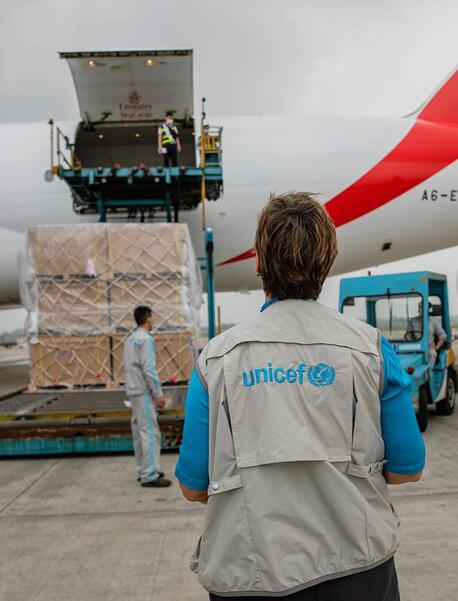
Surmounting Challenges to Get Lifesaving Supplies to Haiti's Children
In Haiti this week, UNICEF managed to get lifesaving support through even as violence further destabilized a collapsing health system. More support is needed as key supply chains remain strangled by armed groups, keeping millions of children at risk of malnutrition and disease. UNICEF Representative Bruno Maes provides an update on one of the world's worst humanitarian disasters.
A health system on the verge of collapse
Six out of 10 hospitals in Haiti are barely operational amid escalating violence in Port-au-Prince, continuing to deprive children of critical health supplies and medicine, UNICEF reported this week.
Every hospital in the country has reported difficulties in acquiring and maintaining essential medical supplies.
“Haiti’s health system is on the verge of collapse,” said Bruno Maes, UNICEF Representative in Haiti. “The combination of violence, mass displacement, dangerous epidemics and increasing malnutrition has bent Haiti’s health system, but the strangling of supply chains may be what breaks it.”
International and domestic cargo flights to and from airports in Port-au-Prince only recently resumed operating — though with limited capacity and a significant backlog, along with the main seaport, which was previously in the hands of armed groups.
Related: Crisis in Haiti: 'I Thought It Was the End for Me'
Containers filled with vital supplies have been held up or were looted, as were many warehouses and pharmacies. Meanwhile, hundreds of containers loaded with humanitarian supplies sit stranded in Port-au-Prince – including UNICEF containers holding neonatal, maternal and medical supplies.

Port-au-Prince, Haiti’s main logistical hub, normally receives and dispatches the consignments of health imports in the country. That hub is now paralyzed by violence — and with over 160,000 residents displaced, the city is unable to cover population needs.
Waves of displaced families seeking safety and security, especially in the southern part of the country, are adding pressure on local health services, which were barely able to cope with demand even before the latest escalation of the country's crisis.
Staff shortages are widespread. Some 40 percent of Haiti's medical staff have left the country due to rising insecurity.
The combination of violence, mass displacement, dangerous epidemics and increasing malnutrition has bent Haiti’s health system, but the strangling of supply chains may be what breaks it. — Bruno Maes, UNICEF Representative in Haiti
About 4.4 million people in Haiti are in urgent need of food assistance, and 1.6 million face emergency levels of acute food insecurity, which increases the risk of child wasting and malnutrition.
The arrival of the rainy season is expected to worsen the situation, bringing a rise in cases of waterborne disease as well as disease spread by mosquitos, such as malaria. Cholera is already a big problem, with 82,000 suspected cases reported between October 2022 and April 2024.
Ramping up alternatives for delivering vaccines, medicines and medical equipment to the children in Haiti who need them most
In response, UNICEF and partners have been ramping up alternatives to the capital’s import and dispatch hubs.
Through secondary import and delivery routes — together with the Ministry of Health, international donors and partners — UNICEF has been able to continue to deliver vaccines, medicines and medical equipment to the children in Haiti who need them most.
In just the last week (on May 18, 20 and 21), UNICEF facilitated the delivery of 38 tons of lifesaving supplies, including health and cholera kits and other essential medical commodities, to Haiti via an air bridge from Panama to Cap-Haitien, where UNICEF and the UN established a new hub, operationalized by the World Food Program with support from European Union Humanitarian Aid.
But much more assistance is needed.
“We cannot allow vital supplies that could save children’s lives to remain blocked in warehouses and containers," Maes said. "They must be delivered now."
Learn more about UNICEF's response to Haiti's crisis, and how UNICEF responds to emergencies all around the world.
Related: How to Talk to Your Children About Conflict and War
UNICEF works around the world to meet the urgent needs of children. Your contribution will make a difference. Please donate today.
HOW TO HELP
There are many ways to make a difference
War, famine, poverty, natural disasters — threats to the world's children keep coming. But UNICEF won't stop working to keep children healthy and safe.
UNICEF works in over 190 countries and territories — more places than any other children's organization. UNICEF has the world's largest humanitarian warehouse and, when disaster strikes, can get supplies almost anywhere within 72 hours. Constantly innovating, always advocating for a better world for children, UNICEF works to ensure that every child can grow up healthy, educated, protected and respected.
Would you like to help give all children the opportunity to reach their full potential? There are many ways to get involved.





